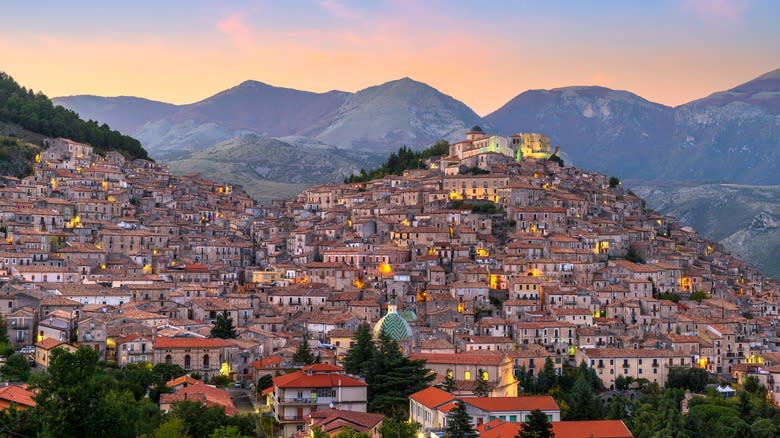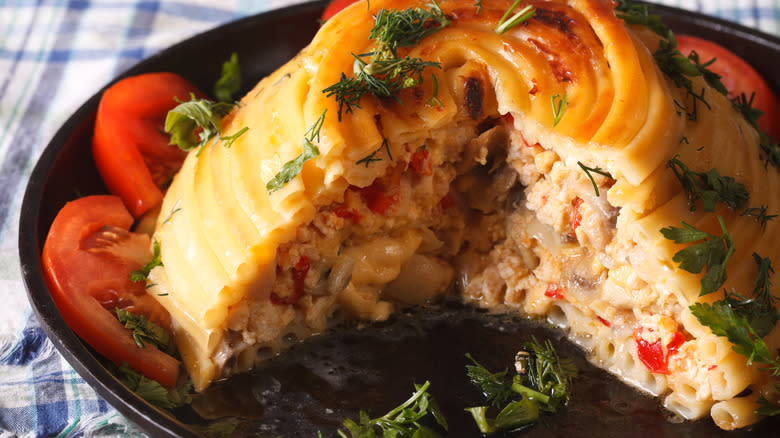Timpano Is The Hearty Pasta Cake That Will Impress All Your Dinner Guests

You may think you've seen it all when it comes to pasta dishes, but rest assured, there are still plenty left to discover, like the unforgettable timpano. In fact, at first glance, you may not even realize it's a pasta dish at all. Timpano is a baked creation featuring noodles, meat, cheese, and veggies, but in the shape of a circular double (or triple) layer cake. Or if you don't think it looks like a cake, you may mistake it for a drum -- at least, that similarity may be what inspired the name for the dish, since "timpano" comes from "tamburo," the word for "drum" in Italian.
If you've ever seen the 1996 film "Big Night," you may recognize this pasta cake as the classic dish that the Italian brothers in the movie use to help save their restaurant. But beyond the movie, timpano has a rich history that goes back to at least 19th-century Italy. It's also called "timballo" in certain areas of the country, and the ingredients can vary by region. Just like in the film, making a drum-sized pasta bake is no small task to take on in real life, but if you are willing to tackle this culinary project, you'll undoubtedly impress your dinner guests.
Read more: 13 Unexpected Ingredients To Elevate Lasagna
Where Does Timpano Come From?

As we mentioned, the roots of timpano go back much further than the 1996 movie. While it may have become a more popular dish in Italy during the 19th century, it was likely originally created by the Medici family's chefs. Though it was made for the wealthy during the Renaissance, it was first invented in Calabria, a region in the south of Italy. Back in the day, a nobleman called Giuseppe di Tomasi di Lampedusa listed his recipe with unlaid chicken eggs. Yet another version, this time from cookbook author Pellegrino Artusi, included pigeon, giblets, bechamel sauce, and macaroni. These early ingredient variations undoubtedly laid the foundation for the differences in timpano all over Italy today.
As you may expect, a pasta dish the size of a cake that takes hours (or days) to make is typically reserved for holidays and festive celebrations. Timpano is a common occurrence at Christmas and Easter parties -- and it was family Christmases in particular that inspired Stanley Tucci, the co-director and actor in "Big Night," to include the meal in the film.
What Goes Into Timpano?

So we know the basic shape of timpano -- but what all goes into an enormous pasta cake? The "Big Night" version includes eggs, salami, ragu, and ziti noodles, but you don't have to stick to this formula. You may see cheeses like provolone, pecorino romano, mozzarella, and ricotta (or a combination of these), meats like prosciutto and Italian sausage, or ingredients like eggplant, tomato sauce, and spinach. As we mentioned, different regions in Italy have their own recipes for the dish -- for example, timballo di scrippelle is a common variety in Abruzzo, which involves meatballs and bechamel sauce stuffed between crepes.
But what really makes a timpano is the assembly of these ingredients, whatever they may be. Pasta dough is typically made by hand and pressed in a deep circular pan (like a Dutch oven), covering the bottom and the sides. Then layers of cooked noodles, sauce, veggies, cheese, and meat go on top, followed by beaten eggs at the end. The whole thing is then sealed in with more rolled-out dough and baked. When it comes to slicing the pasta cake open for all your guests, you'll need a little patience. Typically, a spatula is used to separate the dough from the edge of the pan, then the whole thing is inverted and sliced -- and if you pull it off, you'll likely be rewarded with cheers from the whole room.
Read the original article on Tasting Table.


